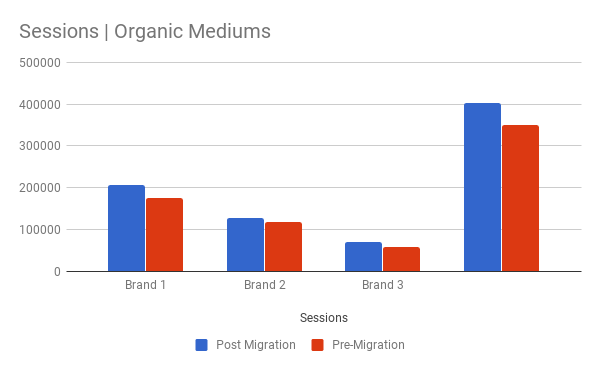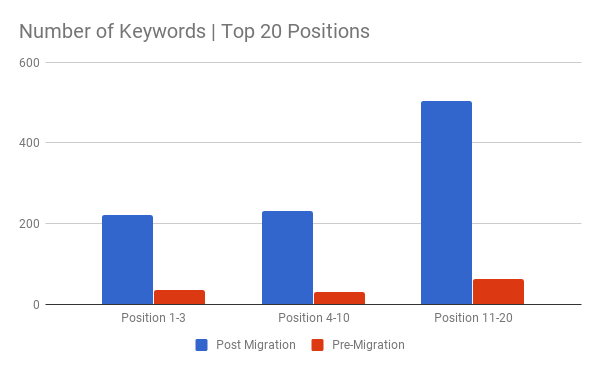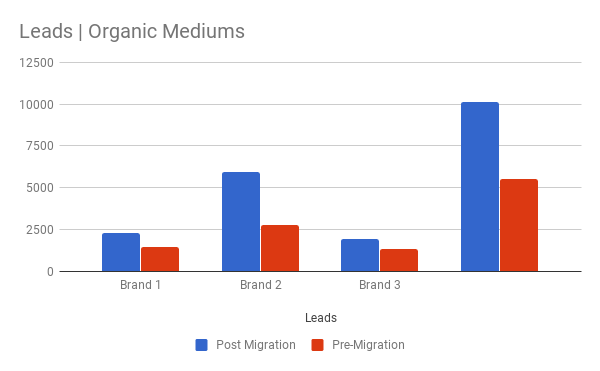Objective:
Our client was in a high demand industry where local visibility was paramount, in the beginning of an aggressive growth plan (fresh off numerous acquisitions with many more on the horizon), and increasing regulatory pressure preventing them from actively engaging in Search Engine Marketing (Search advertising).
They had over 10 domains; all treated separately by Google and were looking for a way to improve the visibility of all of their domains. Most of all, our client was looking to build a model for continued growth; as they pursued continued acquisitions. Our client wasn’t dissatisfied with the short-term SEO visibility of their domains, but worried their current strategy thwarted longer-term organic visibility.
Our long-term goal was to improve rankings for their core unbranded terms, improve their local SEO visibility, improve traffic from organic search, as well as drive more leads from organic search.
Strategy:
Realizing that each brand’s domain was being seen as a separate entity by Google and forced to build its own individual SEO value, our team came to the client with an aggressive strategy; consolidate many brands into one domain. What made this a unique strategy was that individually, the domains were successful, yet required a large amount of individualized effort in order to grow that visibility. As the client continued to purchase more properties, this just further compounded the effort to improve visibility for all properties.
Our theory was that if we bring all of the 10+ domains into one, we would able to consolidate historic SEO value, hoard new SEO value, and create one master domain, with brand specific sub-domains. This particular strategy built the foundation for future long-term scalable growth.
Our plan for this was to treat each individual brand sub-domain as a separate entity, but the top-level domain remained shared across all properties and would quickly raise the SEO value of the entire top-level domain.
What made this strategy even more valuable was that it allowed for sustainable future growth. If the client purchased a new property, it could simply create a new subdomain for that brand, and that property would inherit the historic SEO value of the top-level domain.
Since each brand had a different target audience, both geographically and psychographically, our strategy was to create assets on each subdomain; unique to that specific target audience. These assets included resource centers, blogs, highly specific and relevant service pages, vision pages, and more; thus treating each subdomain a separate business, nestled into one parent top-level domain. Most importantly, the various properties were co-relevant to each other, meaning we were able to make the sum of all domains more relevant for a significantly wider subset of keywords.
Results:
As with any domain level change, immediate SEO results were volatile, but our client knew the long-term impact would be well worth the short-term pain. Part of our plan to mitigate this impact was to consolidate the domains into a domain that already existed. This will in essence bring the historic SEO value of the other 10+ domains into one that already had a strong historic SEO value. This particular tactic showcased almost immediate growth, as within 1 month we were able to secure improvements in the quantity of organic traffic earned for the domain. Even the properties that were moved from their own domain to the branded sub-domain, earned organic traffic on par with pre-migration metrics.
Relative to organic traffic, 6 months after the migration, the client earned an increase of organic traffic by 15%, when compared to the cumulative total of all domains during the 6 months pre-migration.

Relative to keyword rankings, we saw a 941% increase in the quantity of keywords in which all properties ranked in the top 20 positions (this included adding all 10+ previous domains together vs. the consolidated top-level domain). This strategy allowed their top-level domain to become relevant for a larger subset of queries, which continued to build the overall SEO value of the domain.
As it pertains to Local SEO, our client was able to secure top 3 map pack results for 99% of their non-branded target queries, which allowed them to build overall brand awareness for the parent company and effectively pass leads across properties to the facility that made the most sense for that consumer. Cross selling the various properties become a very easy tactic, of which measuring digitally was available. We deployed cross-domain tracking via Google Tag Manager to measure and understand the cross-selling relationship between properties. This allowed them to understand consumer awareness gaps between properties and build a foundation for future acquisitions.
Lastly, the most important factor for the client was the amount of leads they generated from organic search. Within the first 6 months post migration, the client was able to secure 32% more leads form organic search. 12 months post migration, the client was able to increase the quantity of leads 84% vs. the prior year’s cumulative metrics.

Case Study Highlights
Industry: B2C Lead Generation – Healthcare
Goals:
- Increase unique sessions from Organic Search
- Increase leads from Organic Search
- Improve organic search engine rankings for targeted non-branded keywords
- Improve the quantity of keywords in which they rank in the top 20 positions
Results:
- Increased unique sessions from Organic Search by 14%
- Increased leads from Organic Search by 84%
- Increased the quantity of keywords ranking in the top 20 positions by 941% vs. pre-migration rankings.
